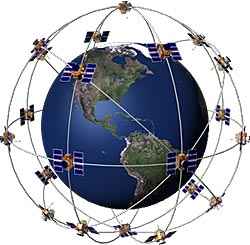Mon, May 31, 2010
GPS IIF-1 Satellite Sends 1st Signals from Space
 The first on-orbit signals from the new GPS IIF-1 satellite,
the inaugural spacecraft in a 12-satellite constellation that the
company is building for the U.S. Air Force have been received. The
signals indicate that the spacecraft bus is functioning normally
and ready to begin orbital maneuvers and operational testing.
The first on-orbit signals from the new GPS IIF-1 satellite,
the inaugural spacecraft in a 12-satellite constellation that the
company is building for the U.S. Air Force have been received. The
signals indicate that the spacecraft bus is functioning normally
and ready to begin orbital maneuvers and operational testing.
A United Launch Alliance Delta IV rocket launched the GPS IIF-1
satellite at 11 p.m. Eastern time on May 27 from Cape Canaveral Air
Force Station. At 2:33 a.m., the satellite separated from the
rocket's upper stage, and a ground station on Diego Garcia in the
Indian Ocean received the first signals from the newest member of
the Air Force's GPS satellite constellation. The Air Force 19th
Space Operations Squadron and Boeing's Mission Operations Support
Center in El Segundo, Calif., confirmed that the satellite is
healthy. GPS signals from the spacecraft payload will be turned on
for test purposes in the coming weeks.
GPS is the U.S. Department of Defense's largest satellite
constellation, with 30 spacecraft on orbit. The GPS IIF satellites
will provide more precise and powerful signals, a longer design
life, and many other benefits to nearly 1 billion civilian and
military users worldwide.
"The inaugural launch of the GPS IIF-1 is a milestone in
Boeing's 30 years of support to the Air Force that goes back to the
first days of this program," said Craig Cooning, vice president and
general manager, Boeing Space and Intelligence Systems. "The new
GPS IIF satellites bring key improvements, including a more
jam-resistant military signal, a new civil signal to enhance
commercial aviation and search-and-rescue operations, and
significantly improved signal accuracy as more of these new
satellites go into operation."
The GPS IIF-1 satellite will undergo months of on-orbit tests,
including functional testing of its payloads and end-to-end system
testing to verify operability with older GPS satellites, ground
receivers, and the ground control system.

Boeing has production of the next 11 GPS IIF satellites well
under way as it implements an innovative pulse-line manufacturing
approach that will help deliver the satellite fleet on schedule.
Adapted from Boeing aircraft and helicopter assembly lines, the
Boeing GPS IIF pulse line efficiently moves satellites under
development from one work area to the next in a steady, pulse-like
rhythm. The second GPS IIF satellite is scheduled for launch later
this year.
More News
"The owners envisioned something modern and distinctive, yet deeply meaningful. We collaborated closely to refine the flag design so it complemented the aircraft’s contours w>[...]
Nonradar Arrival An aircraft arriving at an airport without radar service or at an airport served by a radar facility and radar contact has not been established or has been termina>[...]
From 2022 (YouTube Edition): Still Life with Verve David Uhl was born into a family of engineers and artists—a backdrop conducive to his gleaning a keen appreciation for the >[...]
Also: Electra Goes Military, Miami Air Taxi, Hypersonics Lab, MagniX HeliStrom Amazon’s Prime Air drones are back in the spotlight after one of its newest MK30 delivery drone>[...]
Also: Trailblazing Aviator Betty Stewart, Wind Farm Scrutiny, Chatham Ban Overturned, Airbus Shares Dive A Thunderbird pilot, ID'ed alternately as Thunderbird 5 or Thunderbird 6, (>[...]
 Aero-News: Quote of the Day (12.11.25)
Aero-News: Quote of the Day (12.11.25) ANN's Daily Aero-Term (12.11.25): Nonradar Arrival
ANN's Daily Aero-Term (12.11.25): Nonradar Arrival Classic Aero-TV: David Uhl and the Lofty Art of Aircraft Portraiture
Classic Aero-TV: David Uhl and the Lofty Art of Aircraft Portraiture Airborne-NextGen 12.09.25: Amazon Crash, China Rocket Accident, UAV Black Hawk
Airborne-NextGen 12.09.25: Amazon Crash, China Rocket Accident, UAV Black Hawk Airborne 12.05.25: Thunderbird Ejects, Lost Air india 737, Dynon Update
Airborne 12.05.25: Thunderbird Ejects, Lost Air india 737, Dynon Update




